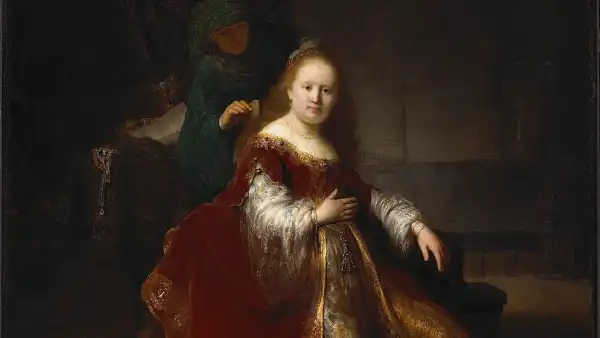
Save this storySave this storySave this storySave this story
The persecution of Jews and their self-defense, not to mention the paranoia surrounding the Jewish people, the relationship between Jews and Persians, the moral dimensions of Jewish reprisals for persecution, even the impulsive actions of short-sighted rulers with a trophy wife – all this seems so removed from our daily concerns that the Jewish Museum’s exhibition on these topics, “Esther in the Age of Rembrandt,” might seem like a fascinating summer pastime.
On the other hand, perhaps it isn’t. In fact, almost everything in the show is what many of us are thinking about at the moment, but reimagined for the 17th century. It’s a wonderfully complex and compelling exhibition, masterfully curated by Abigail Rapoport and Michelle L. Frederick – a palimpsest of great art, fine painting, social history, and religious memory, all woven into the neat knots of a pictorial parable. What Esther symbolizes for Jewish tradition in general, what she meant specifically to Rembrandt’s Sephardic community in Amsterdam, and what she represents in the context of the Dutch struggle for liberation from Spanish rule in Rembrandt’s day and for us today, is a dense tangle of intentions and uncertainties, local allegory and universal applicability that makes paintings speak and art history matter.
Esther’s story, of course, is told in the biblical book that bears her name, which became the basis for the Jewish holiday of Purim. Interestingly, some twenty-five years ago I was asked to tell the story for a Purimshpiel at the same Jewish Museum, then under different management. As a somewhat secularized Jew, I had to take a crash course in Esther and the significance of her story from the eminent Rabbi Isamar Schorsch, then chancellor of the Jewish Theological Seminary. The story, I learned, has much to do with assimilated Jewry: how Ahasuerus, the Persian king, enraged by the feminism of his wife Vashti, dismisses her and holds a beauty contest to choose a new one. An assimilated Jewish girl named Esther wins the contest and becomes his queen. (“What is she eating?” Rabbi Schorsch asked me, confused. “It can’t be kosher.”)
One of the king’s advisers, Haman, comes to hate the Jewish presence at court and in Persia in general, presumably for the usual reasons—Jews are clannish, secretive, too clever, and too ambitious—which culminates when Esther’s cousin Mordecai, another adviser, refuses to bow to him. He decides to organize a pogrom to “destroy, kill, and exterminate” all the Jews in the kingdom, and persuades Ahasuerus to agree. “The money and the people are yours,” the unsuspecting king tells him, “do with them as you please.” Mordecai then turns to Esther for help. She resists, but ultimately decides that if the lives of others depend on her, she has no moral choice but to act.
Esther invites the king to a banquet where, dressed in her finest robes, she asks him to save her people. She also uncovers Haman’s plot against the king, and in a denouement that offends post-Enlightenment sensibilities, Haman and his sons are hanged on the scaffold he intended for Mordecai and the Jews. In “rewriting” the story for the Jewish Museum, I turned it all into a modern allegory in which, well, Donald Trump trades one wife for another, set in the Persian palace of Trump Tower. At the time, imagining Trump as claiming royal privilege was so absurd that it provoked, at least from the pulpit, a kind of ironic mirth.
The Jewish Museum’s new exhibition, created in this new era, is immediately inspired by the loan of a key Rembrandt from the National Gallery of Canada: the 1632 painting Esther with Her Maid, preparing for a banquet where she pleads with her husband. Canadians call this painting “the Jewish heroine of the Hebrew Bible,” because the identity of Esther is so uncertain that Canadians fear that she is easy to identify. And at first glance, we might wonder if this is really Esther. Rembrandt’s queen has a double chin, a full belly, awkward proportions, and a doll-like, shiny face. But a quick glance at the neighboring paintings by his students and followers, which undoubtedly address the Esther theme, using the same iconography and depicting the same relationship between queen and maid, convinces us that it can only be her.
Then we remember that R
Sourse: newyorker.com